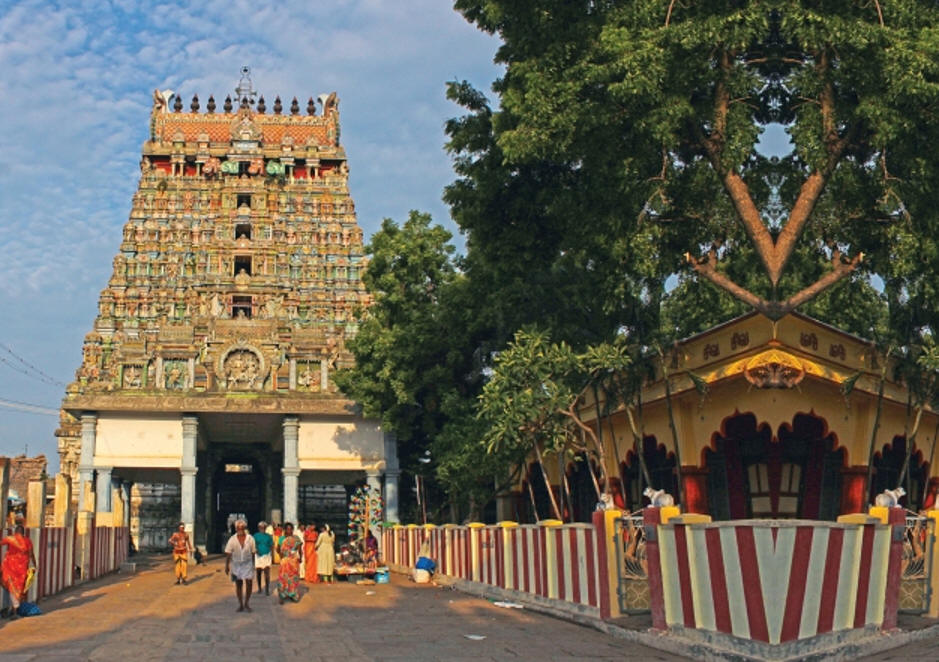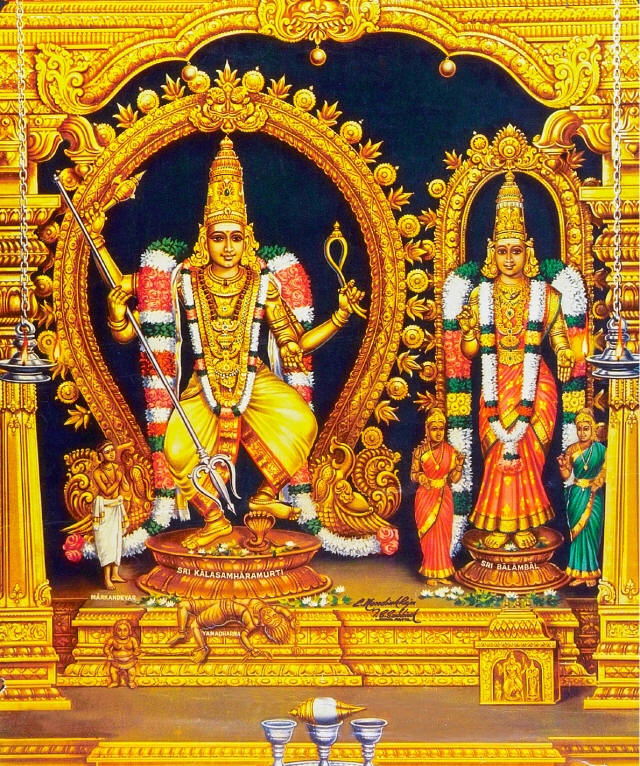KalasamharaMurthy helps remove fear of disease
KalasamharaMurthy = The God who kills Time
Published: 06 Apr 2000 8 PM Updated: 06 Apr 2000 8 PM
பிணி பயம் போக்கும் காலசம்ஹார மூர்த்தி!
Kalasamhara Murthy eliminates fear of disease!
சக்தி விகடன் டீம்
Sakthi Vikatan Team
காலசம்ஹார மூர்த்தி வலையப்பேட்டை ரா.கிருஷ்ணன் Kalasamhara Murthy Valaipettai R. Krishnan
பிரீமியம் ஸ்டோரி Premium Story

2. Prevailing circumstances take over the mind and ruin its tranquility.
3. Here is an example. A contagion has caught the whole world into its grip of fear. Can an individual remain tranquil? Humanity is anxious. These circumstances, beyond one’s control, drive everyone to seek refuge in God. The sacred texts show the way to the worship of Kalasamhara Murthy, supplicating for long life and a disease-free state when we entertain fear of contracting an illness with no medical cure.
4. It is sufficient for us to just think of the greatness of sacred feet of Kāla Kālar, the Amsa of Śivapirāṉ. The diseases and the resultant fear of death will vanish from us. Let us discover the greatness of Kālasamhārar.
5. Time does not wait for anyone and causes inexorable changes to the Mobiles and the Immobiles (cala-acala). Since Śivaperumaṉ controls and manages time, the learned call him Kāla Kālaṉ and Mahā Kālaṉ. Since Śiva kills the ever-dying time, the learned call him Kālasamhārar.

7. Kāl means motion. Since time’s nature is continuous motion with no respite, air also bears the name Kāl. Life does not exist without air. Īsan exists as the Prāṇa Sakthi. Therefore, his name is Kāla Kālaṉ.
8. Born of the sun and Sayādevi, Yamaṉ, without fear or favor, dispenses Dharma and performs his duty, earning the monikers ‘Yama Dharman’ and ‘Nyāyāthipathi.’ Many times, he became arrogant and desired to bind and control the Śiva devotees who transcended time by Śiva’s grace. Śiva prohibits the death of his devotees and surrenderers and dispenses grace. He frees them from the birth-death-rebirth cycle. Since he destroys Yamaṉ defeating him from usurping the lives of the Śiva devotees, Śiva goes by the name, ‘Yama Samhārar.’
9. Śiva is the vanquisher of death (‘Mṛthyu’). He is ‘Miṛyuyuñjayar,’ as praised by his devotees. Śivaperumāṉ is the time delimiter of Yama himself and thus goes by many names: Kālānthakar, Kālāri, Kāla Kālar, Kālasamharar, and Kālakaṇdaṉ.
10. Kālasamhārar history is ubiquitous in its occurrence in the Śaiva Thirumurai sacred texts. This icon has four or eight holy hands. In Kāmikāmamam Śivaperumāṉ’s left leg kicks Yama, the right leg anchors on the earth, and the right-hand trident stabs the neck of Yama.
11. Perumāṉ destroying the Asuras kicked Kālaṉ to benefit his devotee. The son of Kausika Muṉi is Mṛkaṇḍa, whose wife was Mṛthuvathi. Upon doing Tapas, they had a son Mārkaṇḍeya.
12. Mārkaṇḍeya was sixteen, and Yama came to usurp his life. Mārkaṇḍeya, immersed in the worship of Śiva, heard the call of Yama and immediately embraced the Śivaliṇgam. Yama pulled both Mārkaṇḍeya and the Liṇgam with a noosed rope. Śivaperumāṉ emerged from the Liṇgam and kicked Kālaṉ. Kālaṉ fell, and Mārkaṇḍeya received the boon to be sixteen forever.

Sri Kālasamhāra Mūrthy and Sri Ambal
13. The indwelling God, offering the boon, disappeared soon after that in the Liṇgam. That day he received the boom was in Phalguṉi month, and Revathi Nakshatra with the moon and the Guru at their summit.
14. Thirukkadavūr near Mylāduthurai is the site of the temple that depicts the annihilation of Yama benefitting his devotee Mārkaṇḍeya. Since the temple stands past the dissolution and helps the devotee go past the fear of time, it is called Kadavūr.
15. Kāsi was the place where God destroyed Yama to benefit Mārkaṇḍeya, who performed Tapas at the confluence of Gomathy and Sarayu rivers, also known as Mārkaṇḍeya Āsrama according to the Purāṇās.
16. Mārkaṇḍeya, establishing and worshipping Śivaliṇgam, took Ganges water and a vine of piñjalam flower, visited a multitude of temples and at last reached Thirukkadavūr. He planted the vine there, poured the Ganges water in the temple well, and implored Ganga Devi to take her residence in the well. That well water carries the eponymous name of Mārkaṇḍeya Tīrtham and Asupathi Tīrtham, whose location is to the south of Thirukkadavūr cremation ground temple. The priests bring the water from the well for the daily ablution of Thirukkadavūr Amirthakatēsvarar.
17. Śiva Temple in Manalmedu near Thirukkadavur is where Mārkaṇdēyar worshipped the central deity, Mārkaṇdēsvarar. The temple has an idol of Ambikai Maruththuvathi, the name of the mother of Mākaṇdēsvarar. There is a small exclusive temple for Mārkandēyar, who appears here doing Pūjai to Śivaliṇgam.
18. The statues of Kālasamhārar in the temples in Thirkkadvūr, Thiruseṇkāttaṇkudi, Thiruvīzimizalai, and others are stone or five-metal pieces. In Atta Vīratta temples, Kālasamhāra Mūrthy appears in a dancing pose.
19. Kālasamhāra Mūrthy’s form appears fantastic in Chidambaram and Madurai temples. The temples dedicated to Kālasamhāra Mūrthy thrive in Thiruveṇkādu, Thiruvaikāvūr, and Thiruvaiyāṛu. The laudatory icons of Kālasamhāra Mūrthy in Thiruvīzimizalai appear as grace giver to Suvētha Kētu and in Thiruvaiyaṛu as Āṭkoṇdār (Enslaver to God).
20. If Yama sustains death, the people don’t die. The Earth Goddess suffering from the burden supplicated to Tirumāl, who along with Brahma petitioned to Śivaperumāṉ. Śivaperumāṉ heeding to their request brought Yama back to life and gave him the portfolio of death. Śiva because of his power to destroy and create carried the moniker, Adhikāravallapar, meaning the One capable of exercising great power.
21. The temple where Yama’s power does not prevail.
22. Thirukōdikkā is the much-celebrated temple with attributed poems on the road between Mayilāduthurai and Kumbakōṇam near Thiruvāduthurai. In Rudrakōdi Samhita, this temple receives praise as Vēthravaṉam. The treatise says that people living there do not suffer any trouble or punishment from Yama. That is why there is no crematorium in this town. The final rites of the people who die here take place on the south side of the Kāvēri river. Yama’s ordinance has a null effect in some Śiva temple locations, as in Kāsi.
23.Yama Bhairavar
24. Agathīsvarar Temple with Āṉantha Valli is in Kotiyanūr near Thirumīyacchūr, famous for Lalithāmbikai temple). In this temple, near Yama Dharman, Bhairava, and Yama’s brother Saṉaiccharaṉ are the resident deities offering grace.